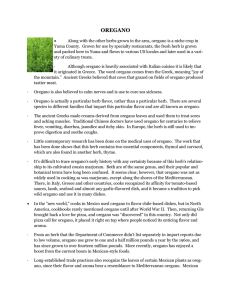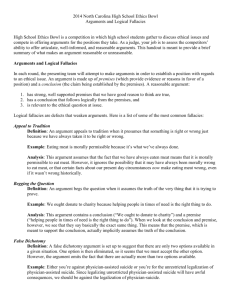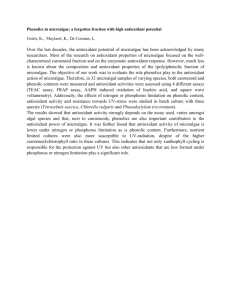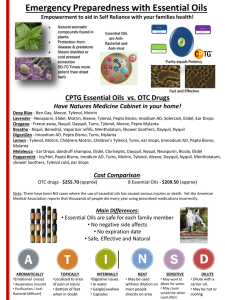Aromatherapy Research Article May 2015 Oregano Oil in Food
advertisement
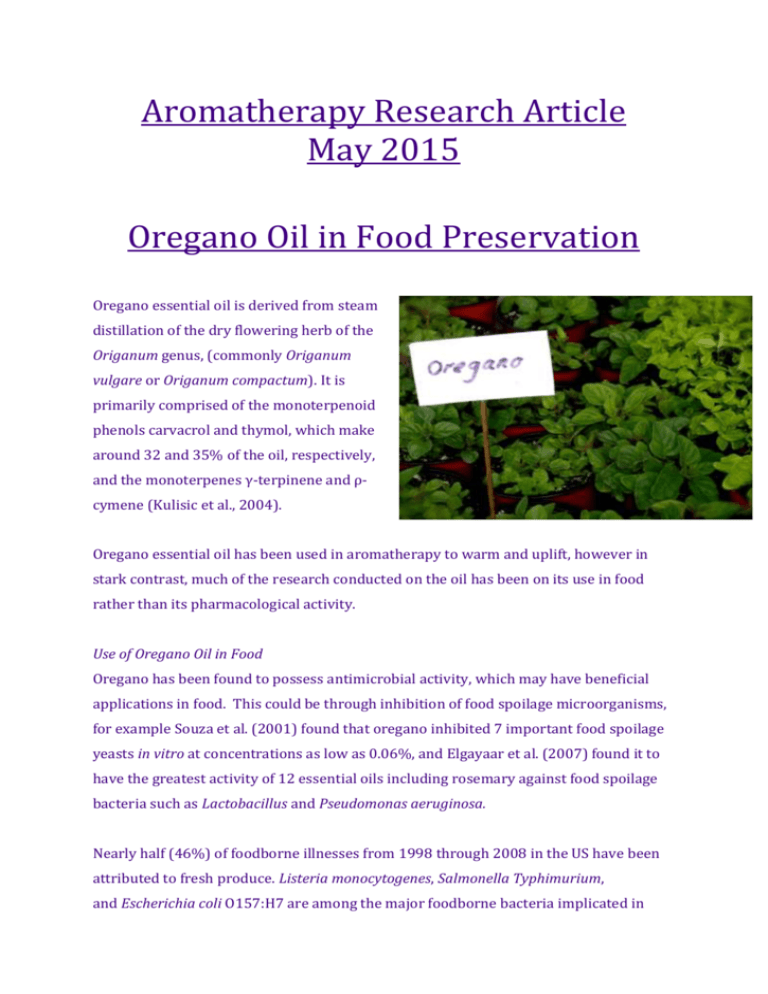
Aromatherapy Research Article May 2015 Oregano Oil in Food Preservation Oregano essential oil is derived from steam distillation of the dry flowering herb of the Origanum genus, (commonly Origanum vulgare or Origanum compactum). It is primarily comprised of the monoterpenoid phenols carvacrol and thymol, which make around 32 and 35% of the oil, respectively, and the monoterpenes γ-terpinene and ρcymene (Kulisic et al., 2004). Oregano essential oil has been used in aromatherapy to warm and uplift, however in stark contrast, much of the research conducted on the oil has been on its use in food rather than its pharmacological activity. Use of Oregano Oil in Food Oregano has been found to possess antimicrobial activity, which may have beneficial applications in food. This could be through inhibition of food spoilage microorganisms, for example Souza et al. (2001) found that oregano inhibited 7 important food spoilage yeasts in vitro at concentrations as low as 0.06%, and Elgayaar et al. (2007) found it to have the greatest activity of 12 essential oils including rosemary against food spoilage bacteria such as Lactobacillus and Pseudomonas aeruginosa. Nearly half (46%) of foodborne illnesses from 1998 through 2008 in the US have been attributed to fresh produce. Listeria monocytogenes, Salmonella Typhimurium, and Escherichia coli O157:H7 are among the major foodborne bacteria implicated in produce outbreaks, thus prevention and control of bacterial contamination on fresh produce is needed to ensure food safety. A scanning electron micrograph of Listeria monocytogenes. The current microbial control strategy of fresh produce such as lettuce is industrial washing of the product in water containing chlorine. However, this does not reduce the microbial load greatly and potential health concerns are associated with chlorine byproducts. Therefore, there is an urgent need to identify alternative antimicrobials for the produce industry. Oregano oil was found to possess antimicrobial activity against Listeria monocytogenes, Staphylococcus aureus and Escherichia coli 0157:H7 (Souza et al., 2007), indicating that this could be used in food decontamination. To test whether the antimicrobial activity would translate to food systems, Bhargava et al. (2015) inoculated lettuce with Listeria monocytogenes, Salmonella Typhimurium and Escherichia coli O157:H7, and dipped the samples in oregano nanoemulsions (0.05% or 0.1%) for one minute. Samples were stored at 4 °C and enumerated for bacteria at 0 h, 3 h, 24 h, and 72 h. Compared to control of no treatment, oregano nanoemulsion showed an up to 3 log(10) CFU/g rreductions in L. monocytogenes, S. Typhimurium, and E. coli O157:H7, equivalent to a kill of 99.9%. Therefore, oregano oil nanoemulsions could indeed be an effective alternative antimicrobial control strategy in fresh produce. The antimicrobial effect could also be exploited in meats and other produce through incorporation into food packaging or edible films. Antibacterial activity of soy protein edible films incorporated with 5% oregano oil on fresh ground beef patties was evaluated against the food poisoning bacteria Escherichia coli, E. coli O157:H7 and Staphylococcus aureus, and the food spoilage organisms Pseudomonas aeruginosa and Lactobacillus plantarum during storage at 4 °C. Inhibition of all tested bacteria was seen, while live numbers P. aeruginosa and E. coli were reduced (Emiroglu et al. (2010). This suggests that oregano oil in soy protein edible films could help preserve ground beef patties and other meat products. Chitosan films, a type of biodegradable food packaging, could also be prepared with oregano oil to reduce microbial contamination. Chi, Zivanovic and Penfield (2006) packaged bologna slices in oregano oil-incorporated chitosan films. There was a sharp decrease in essential oil components in the chitosan films after application as it diffused into the bologna, with no carvacrol being detected after 5 days at 4°C. This could be acceptable as it diffused into the meat, producing an antimicrobial effect. Sensory evaluation was also conducted, and suggested that addition of 45 parts per million or less of oregano oil to bologna would be acceptable to consumers, which would be high enough to retain the antimicrobial effect. Lipid oxidation in meat, particularly cooked meat, is one of the reasons for quality degradation during storage. This process is associated with the presence of free radicals that lead to the production of aldehydes responsible for the development of rancid flavours and changes in the colour. Antioxidants prevent this from occurring (Fasseas et al., 2008). Synthetic antioxidants are often currently used and many of these have been suspected to have a carcinogenic potential (cancer-causing), indicating the need for novel alternatives (Botsoglou et al., 2002). Oregano essential oil was found to possess significant antioxidant activity. Kulisic et al. (2004) found that the total essential oil as well as its pure constituents have a significant antioxidant effect. The antioxidant activity of the oregano essential oil was comparable with the synthetic antioxidant butylated hydroxytoluene, suggesting it may be a novel alternative to this. The synergy among minor oxygen containing compounds was suggested to influence the antioxidant power of the oregano essential oil. As such oregano could be used as a safer alternative to synthetic antioxidants used in food. In support of this, Fasseas et al. (2008) found that treatment of ground pork and beef samples with 3% oregano significantly decreased oxidation at 1, 4, 8 and 12 days of storage at 4°C compared to controls without antioxidants and sage oil. This effect was greater in cooked meats than raw meats. Goulas and Kontominas (2007) tested the antioxidant effects of oregano on sea bream, finding a greater antioxidant effect in fish treated with salt and 0.8% oregano compared to salting alone. Sensory testing of the fish was used to determine shelf life, and while the salted samples remained acceptable up to 20–21 days, oregano oil addition resulted in acceptable sensory qualities after 33 days of storage yielded. The oregano was said to give a distinct but pleasant flavour to the fish. Alternatively, dietary supplementation of oregano oil could provide a simple, convenient way of introducing the antioxidant properties to meat compared to treating meat with the oil. In one study, day-old chickens were randomly divided into four groups and fed a diet containing 30 mg/kg α-tocopheryl acetate (an antioxidant) as control, 200 mg/kg α-tocopheryl acetate, or 50 or 100 mg/kg oregano essential oil for 38 days prior to slaughter. Lipid oxidation was assessed in raw and cooked meat during 0, 3, 6 and 9 days of refrigerated storage. Results showed that dietary oregano essential oil supplementation exerted antioxidative effects, with the 100mg/kg dose proving most effective. However, dietary α-tocopheryl acetate supplementation at 200 mg/kg feed displayed greater antioxidant activity than oregano treatments (Botsoglou et al., 2002). In conclusion, the need for new alternatives to current food treatment strategies are needed due to their potential health risks. Scientific studies have shown promise for the use of oregano oil in increasing shelf life of fresh produce and meats, through reducing food spoilage microorganisms and reducing lipid oxidation that leads to rancidity, and making them safer through decreasing contamination with food poisoning bacteria. This multi-faceted action could mean that we may see oregano being used in the future after further evaluation. References BHARGAVA, K. et al. (2015) Application of an oregano oil nanoemulsion to the control of foodborne bacteria on fresh lettuce. Food Microbiology, 47 (0), pp. 69-73. Botsoglou, N.A. et al. (2002) The effect of dietary oregano essential oil on lipid oxidation in raw and cooked chicken during refrigerated storage. Meat Science, 62 (2), pp. 259-265. Chi, S., Zivanovic, S. amd Penfield, M.P. (2006) Application of Chitosan Films Enriched with Oregano Essential Oil on Bologna – Active Compounds and Sensory Attributes. Food Science and Technology International, 12, pp. 111-117. Emiroğlu, Z.K. et al. (2010) Antimicrobial activity of soy edible films incorporated with thyme and oregano essential oils on fresh ground beef patties. Meat Science, 86 (2), pp. 283-288. Fasseas, M.K. et al. (2008) Antioxidant activity in meat treated with oregano and sage essential oils. Food Chemistry, 106 (3), pp. 1188-1194. Goulas, A.E. and Kontominas, M.G. (2007) Combined effect of light salting, modified atmosphere packaging and oregano essential oil on the shelf-life of sea bream (Sparus aurata): Biochemical and sensory attributes. Food Chemistry, 100 (1), pp. 287-296. Kulisic, T. et al. (2004) Use of different methods for testing antioxidative activity of oregano essential oil. Food Chemistry, 85 (4), pp. 633-640. Souza, E.L. et al. (2007) Effectiveness of Origanum vulgare L. essential oil to inhibit the growth of food spoiling yeasts. Food Control, 18 (5), pp. 409413.
